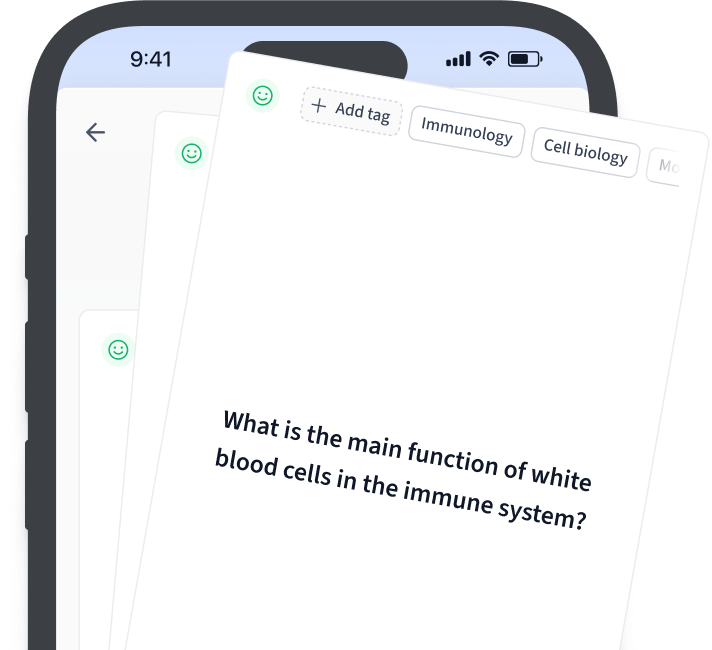Blood Components - Definition
Blood is a vital fluid in the human body, comprising various components that each serve specific functions. Understanding the components of blood is crucial to grasp the role blood plays in overall health. The primary components include red blood cells, white blood cells, platelets, and plasma.Each of these components interacts in complex ways to maintain homeostasis and ensure proper bodily functions.
Red Blood Cells (RBCs): Cells in the blood that carry oxygen from the lungs to the body and return carbon dioxide for exhalation.
White Blood Cells (WBCs): Cells involved in the immune response, tasked with protecting the body against infections and foreign invaders.
Platelets are small cell fragments that are essential components of blood, primarily involved in blood clotting and wound healing. They work alongside other blood components, such as red blood cells, which transport oxygen, and white blood cells, which defend against infections. Understanding the functions and composition of blood plasma, including platelets, is crucial for comprehending the body's immune response and overall health.
Plasma: The liquid component of blood, comprising about 55% of its total volume, plays a crucial role in transporting cells, nutrients, hormones, and waste products throughout the body. It contains various proteins, electrolytes, and water, contributing to essential functions such as maintaining blood pressure and volume. Additionally, plasma supports the immune response by transporting immune response cells and facilitating the function of red blood cells in oxygen transport and white blood cells in infection defense. Understanding blood plasma functions and composition is vital for comprehending overall health and disease mechanisms.
Let’s take a closer look at these components:
- Red Blood Cells: Also known as erythrocytes, these cells are disc-shaped and lack a nucleus, allowing for more space to carry hemoglobin. Hemoglobin binds with oxygen, facilitating its transport through the bloodstream.
- White Blood Cells: The body's defense mechanism, these cells are larger than red blood cells and come in various types, each with its specific role, such as attacking pathogens or producing antibodies.
- Platelets: Derived from megakaryocytes in the bone marrow, these small fragments are essential for clot formation, preventing excessive bleeding.
- Plasma: Comprising approximately 55% of blood volume, plasma is mostly water and serves as a transport medium for cells and various substances.
For instance, in cases of anemia, a person may have a reduced number of red blood cells, leading to fatigue and weakness due to decreased oxygen transport. Alternatively, an increase in white blood cells may suggest an infection, as the body is responding to foreign pathogens.
The balance between these blood components is crucial for maintaining health. Any significant alterations can lead to various medical conditions. For instance, a decrease in platelets might result in a higher risk of bleeding disorders, while an increase in white blood cells can indicate chronic inflammation or infection.Understanding blood components also opens doors to treatments and therapies aimed at correcting these imbalances, such as blood transfusions, medications to stimulate blood cell production, or targeted treatments for specific blood disorders.
It’s beneficial to recognize that the normal ranges for each component can vary with age, sex, and health status.
The body has a remarkable ability to regulate the levels of these blood components. Erythropoiesis, the production of red blood cells, is stimulated by a hormone called erythropoietin, primarily produced by the kidneys in response to low oxygen levels. Similarly, white blood cell production is influenced by various cytokines and growth factors, depending on the body's immune demands. Platelet counts are also tightly regulated and can become elevated due to stress or inflammation.Blood plasma contains proteins such as albumin, globulins, and fibrinogen, which play critical roles in functions such as maintaining osmotic pressure, forming antibodies, and aiding in blood clotting, respectively. Its composition is crucial, as it influences how nutrients, hormones, and waste products are distributed throughout the body. Therefore, a deeper understanding of blood components can lead to enhanced approaches in both diagnostics and treatment.
Components of Blood Explained
Blood is composed of several key components, each playing a unique and essential role in maintaining bodily functions. The main components include red blood cells, white blood cells, platelets, and plasma.Understanding these components helps illustrate how blood contributes to overall health.
Red Blood Cells (RBCs): Cells responsible for transporting oxygen from the lungs to the rest of the body.
White Blood Cells (WBCs): Cells that are part of the immune system, helping to protect the body from infection.
Platelets are essential blood components that play a critical role in the process of blood clotting, helping to prevent excessive bleeding. These small cell fragments work in conjunction with other immune response cells and white blood cells to maintain hemostasis and support the body's defense against injury and infection. Understanding the functions of platelets, along with red blood cells that transport oxygen and blood plasma that carries nutrients, is vital for comprehending overall blood health and its various roles in the human body.
Plasma: The liquid component of blood, comprising approximately 55% of its total volume. It contains water, electrolytes, proteins, hormones, and waste products. Plasma plays a crucial role in transporting nutrients, hormones, and proteins throughout the body. Additionally, it supports the immune response by carrying immune response cells and facilitates the transport of red blood cells for oxygen delivery and white blood cells for infection defense. Understanding the blood plasma functions and composition is essential for grasping the overall dynamics of blood components.
Now, let’s dive deeper into the functions of these components:
- Red Blood Cells: Besides transporting oxygen, they also help carry carbon dioxide back to the lungs for exhalation.
- White Blood Cells: There are several types of WBCs, including lymphocytes and neutrophils, each specializing in different immune functions.
- Platelets: They aggregated form a plug to initiate the clotting process.
- Plasma: Comprises about 55% of blood volume and contains important proteins such as albumin, which maintains oncotic pressure.
For example, in someone with anemia, there are typically fewer red blood cells than normal, leading to symptoms such as fatigue and pallor. Conversely, a significant increase in white blood cells can indicate the presence of an infection, prompting a closer examination to identify the underlying cause.
Keep in mind that normal ranges for blood components can vary based on age, sex, and health status.
Blood is not merely a fluid but a complex tissue comprised of various components that work synergistically. Hemoglobin, found in red blood cells, is a key protein that binds oxygen; without it, oxygen wouldn't effectively reach tissues. The production of blood components happens primarily in the bone marrow, with erythropoiesis being the process that generates red blood cells, stimulated by the hormone erythropoietin from the kidneys. Leukopoiesis is the formation of white blood cells, which includes multiple lineages responding to various threats.Platelets arise from megakaryocytes, large cells in the bone marrow, and their formation is essential during injuries to promote coagulation, reducing the risk of blood loss. Plasma consists of about 90% water and contains a variety of substances, including electrolytes and nutrients necessary for cell metabolism, making it critical in various physiological functions. Understanding the details of how these components function and interact can provide insights into numerous health conditions and the pathways for treatments.
Example of Blood Components and Their Functions
Blood consists of several key components, each performing crucial roles that contribute to the body's overall functionality. Understanding these components can provide important insights into physiological processes and health conditions.The main components of blood include red blood cells, white blood cells, platelets, and plasma. Each of these components interacts to maintain the balance and health of the body.
For instance, consider an individual with anemia. In this case, there would typically be a decreased level of red blood cells, resulting in symptoms such as fatigue and weakness due to less efficient oxygen transport throughout the body.
Conversely, a person with an active infection may exhibit an elevated number of white blood cells. This response indicates the body is actively working to fend off pathogens, showcasing the immune system's function.
Let's delve deeper into how these blood components carry out their functions:
- Red Blood Cells (RBCs): Transport oxygen bound to hemoglobin from the lungs to tissues and carry carbon dioxide back to the lungs.
- White Blood Cells (WBCs): Vital in the immune system, multiple types of WBCs provide defense against infections and foreign substances.
- Platelets: Key players in hemostasis, they aggregate at sites of blood vessel injury to minimize blood loss by forming a temporary plug.
- Plasma: The liquid component that contains water, electrolytes, nutrients, and proteins, serving as a medium for transporting cells and various substances.
It's useful to remember that the proportion of these components can indicate health status and the presence of various diseases.
Blood components perform functions that are vital for survival. For example, erythropoiesis is the process of red blood cell production, which occurs in the bone marrow and is regulated by erythropoietin hormone in response to oxygen levels in the blood.White blood cells are produced through a process called leukopoiesis and vary in types, such as lymphocytes and neutrophils, depending on their specific roles in immune defense.Platelets, or thrombocytes, are derived from megakaryocytes and play a crucial role in the clotting process, responding immediately when vessels are injured.Plasma, making up about 55% of blood volume, transports not just blood cells but also nutrients, hormones, and waste for excretion. Plasma proteins, like albumin and fibrinogen, are essential for maintaining osmotic pressure and facilitating clotting, respectively. This integration of different blood components highlights their importance in maintaining homeostasis and responding to bodily needs.
Meaning of Blood Components in Diagnosis & Therapy
Understanding blood components is critical in medical diagnostics and therapies. Each blood component plays a unique role in the body, and their measurement can provide valuable information regarding a patient's health status. Blood tests that evaluate these components are often used to diagnose conditions such as anemia, infection, and clotting disorders.The key blood components include red blood cells, white blood cells, platelets, and plasma. Each of these components can indicate different medical conditions, and their levels can guide treatment decisions.
For example, a complete blood count (CBC) test measures the levels of red blood cells and white blood cells. A low red blood cell count may indicate anemia, which might require iron supplementation or dietary changes, while an elevated white blood cell count could signal an infection, requiring antibiotics.
Remember that different blood components have normal ranges, and deviations from these can suggest specific medical conditions.
A thorough understanding of blood components can provide insights into various therapies. Red blood cells are essential for oxygen transport, and in cases of severe anemia, blood transfusions may be necessary to restore adequate oxygen delivery to tissues. White blood cells are crucial for immune function. Their levels can vary significantly, and conditions like leukemia can result in abnormal white blood cell counts, requiring targeted therapies such as chemotherapy or immunotherapy to manage these conditions.Platelets play a vital role in clotting, and a reduced platelet count can lead to increased bleeding risk. In such scenarios, treatments may include platelet transfusions or medications to stimulate platelet production.Finally, plasma contains proteins like clotting factors and antibodies. Understanding its composition can guide treatments in patients with coagulation disorders or immune deficiencies, highlighting the significance of each blood component in both diagnosis and therapy.
blood components - Key takeaways
- The definition of blood components includes red blood cells, white blood cells, platelets, and plasma, each performing unique and essential functions related to overall health.
- Red blood cells (RBCs) are responsible for transporting oxygen and carbon dioxide, playing a key role in gas exchange in the body.
- White blood cells (WBCs) are crucial for the immune response, helping to protect the body against infections and foreign invaders.
- Platelets are small cell fragments vital for blood clotting and wound healing, preventing excessive bleeding.
- Plasma, making up about 55% of blood volume, serves as a transport medium for cells, nutrients, hormones, and waste products in the body.
- Understanding the components of blood is essential for diagnosis and therapy; changes in their levels can indicate various health conditions, guiding medical interventions.
References
- Shannon L. Cartwright, Marnie McKechnie, Julie Schmied, Alexandra M. Livernois, Bonnie A. Mallard (2021). Effect of In-vitro Heat Stress Challenge on the function of Blood Mononuclear Cells from Dairy Cattle ranked as High, Average and Low Immune Responders. Available at: http://arxiv.org/abs/2105.08801v1 (Accessed: 26 March 2025).
- S. L. Cartwright, J Schmied, A Livernois, B. A. Mallard (2022). Effect of In-vivo Heat Challenge on Physiological Parameters and Function of Peripheral Blood Mononuclear Cells in Immune Phenotyped Dairy Cattle. Available at: http://arxiv.org/abs/2201.02675v1 (Accessed: 26 March 2025).
- John Paul Gosling, Sheeja M. Krishnan, Grant Lythe, Benny Chain, Cameron MacKay, Carmen Molina-París (2018). A mathematical study of CD8+ T cell responses calibrated with human data. Available at: http://arxiv.org/abs/1802.05094v1 (Accessed: 26 March 2025).











